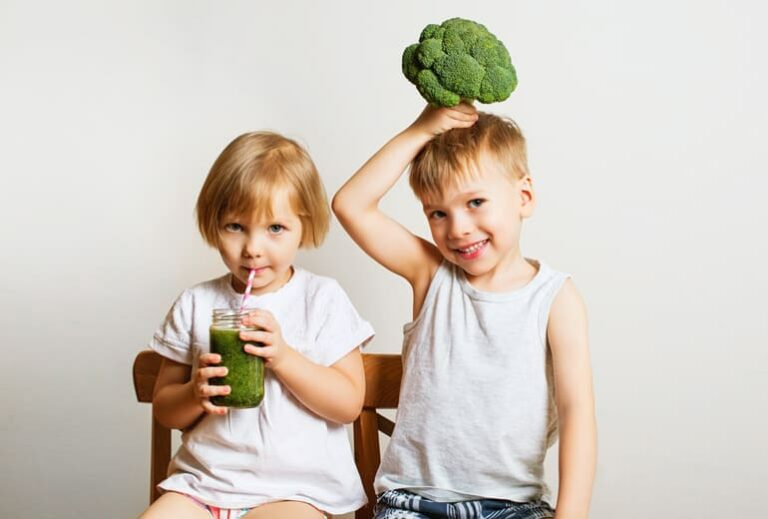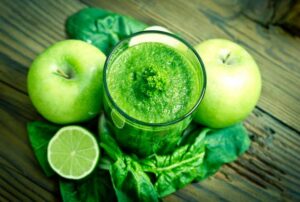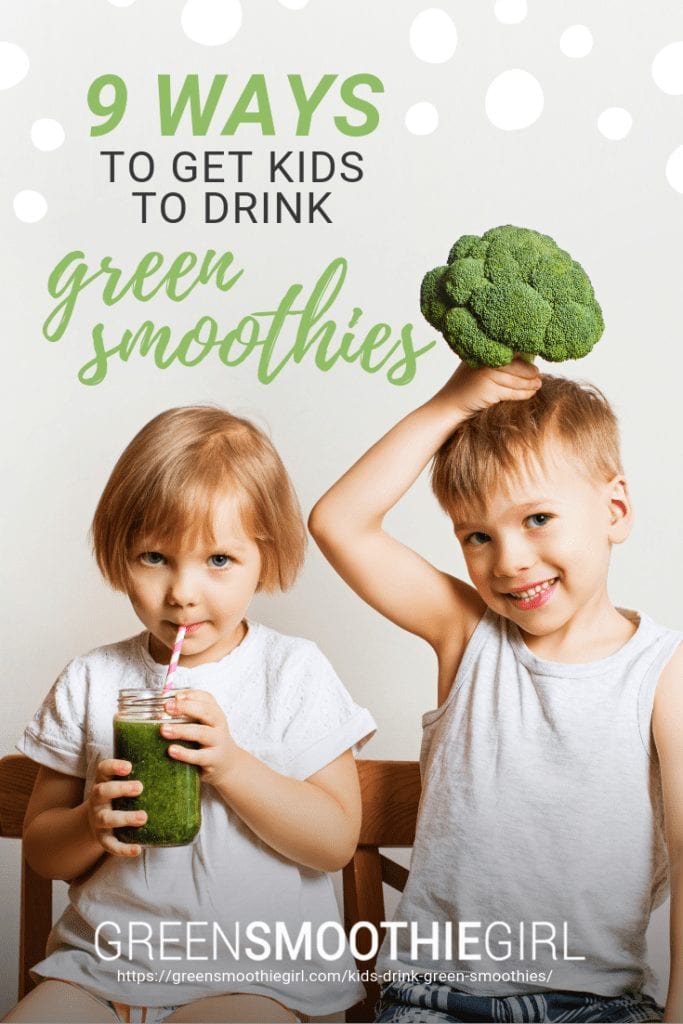9 Ways to Get Kids to Drink Healthy Green Smoothies

If you’re in the habit of drinking a green smoothie every day, you already know how healthy and delicious it is.
You probably even reap some of the benefits, including more energy, weight loss, better digestion, skin tone improving, and fewer cravings for sweets and processed foods. (My survey of 175 new green smoothie drinkers yielded these top 5 answers, published in The Green Smoothies Diet.)
Of course, it’d be even better if you could get your family on the bandwagon, and if you’re like hundreds of parents who have asked me over the years, you may be wondering how to get kids to drink healthy green smoothies.
The nice thing about getting more nutrient density in a child’s diet, in the form of a pint of green smoothie a day (which is 7+ servings of raw greens, superfoods, and fruit), is that he or she is less likely to beg you for candy and treats, especially as an after-school smoothie becomes a habit.
[Want an easy way to enjoy the benefits of more green smoothies – for you and your whole family? Our Fall Green Smoothie Challenge begins soon. It's free to join. Check it out here.]
In this article:
- Start with something your kids already love.
- Be smart about how you serve it.
- Include your kids in the selection and preparation process.
- Teach them to whip it and shake it!
- Work with your kids, not against them.
- Pull back on pressure, but take responsibility.
- Make it matter -- what's in it for them?
- Set a good example
- Challenge each other.
The epic battle between kids and parents who want them to eat their veggies is a common one, but including greens as part of a healthy diet is crucial for children’s development, as well as reducing the risk of chronic disease and helping maintain a healthy body weight.1
The US Department of Agriculture ChooseMyPlate tool2 recommends that kids fill half their plates with fruits and vegetables at every meal, aiming for one to two cups of fruits and one to three cups of vegetables each day, depending on a child’s age and sex. Sadly, the Center for Disease Control reports that 60% of kids don’t meet daily recommendations for fruit, and 93% don’t eat enough vegetables.3
And most other government estimates are far lower. The USDA reports that the average American child eats just 1-2 vegetables and fruits daily, with most of those being in the form of ketchup, french fries, and the juice to wash it all down.
These aren’t exactly the best fruits and vegetables. (If I were in charge of classifying foods, I'm not sure that I would call french fries a vegetable.)
What if you could get spinach, kale, chard, sprouts, blueberries, cashews, flaxseed, ginger, and turmeric in your child (just an example of what you could throw in the blender) before she starts her school day, every day? It’s brain food for getting As and staying focused and happy!
And what’s even better, it’s not particularly expensive, and it can be achieved in 10 minutes every morning, with a good blender.
As a parent, would you be excited about that?

If you can get your kids on board with green smoothies, you have an easy way to help them get the vitamins, minerals, calcium, fiber, and other nutrients they need.
[Related: 10 Easy Green Smoothies Kids of All Ages Will Love]
Luckily, there are plenty of ways to make it happen and make it easier. I’m a veteran green-smoothie mom, having raised four children to adulthood drinking green smoothies daily. I think I’ve pretty much seen it all, and everything I share with you below came from the “school of hard knocks.”
For instance, I learned early in the process NOT to send the daily pint of green smoothie to school in the lunchbox. It’s too easy for them to not drink it, because 5th graders care about little more than not standing out among their peers. Blended spinach isn’t exactly standard in school lunches.
For us, the green smoothie as breakfast or after-school snack worked better, because I was there to supervise it.
What happened when I took my eye off the ball? I once found 11 pints of rotten green smoothies in my younger daughter’s bedroom, in a toy “treasure chest.” Apparently she hadn’t learned to “treasure” nutrition yet. I had been wondering what happened to all my pint jars, which sent me on a treasure hunt that ended in Libby’s closet.
(Happy update: that same girl loves plant-based, whole-foods nutrition now. She's away at college and asking for tips and help on a weekly basis because she’s learned she feels better when she eats greens, vegetables, fruits, legumes, whole grains, and nuts and seeds as the foundation of her diet. Teaching your kids correct principles when it comes to nutrition is something we both model and teach, and the benefits aren’t always immediate.)
Check out some of the tips and tricks I’ve learned through the years for how to get kids to drink healthy green smoothies, and watch your kids start slurping!
1. Make it Familiar and Fun: Start with something your kids already love.
To get kids to drink green smoothies painlessly, think of developing this habit as a process rather than an event. If your kids are new to whole foods, and you’re trying to right the course now that they’re rather addicted to processed foods, start out simply with ingredients they already love.
Make sure some dark-colored berries are involved at first. A “green smoothie” doesn’t actually have to LOOK green (a color that kids may react to negatively, at first) -- it just has to have greens in it!

Use flavorful fruits like berries, pineapple, or peaches that have natural sweetness, and use only mild-tasting greens like spinach to start. After your kids love green smoothies, you can sneak in higher amounts of greens and other superfood ingredients like cabbage, sprouts, bee pollen, and ginger.
Here are two yummy green smoothie recipes, with video demos, that are perfect for starting kids out with:
2. Be smart about how you serve it.
Getting your child to try a green smoothie can be an uphill battle, but a little creativity goes a long way. Whip up a concoction and give it a fun name you know will entice your child.
If your child can’t get enough of Marvel comics, make a vivid green smoothie and call it “Hulk Juice.” Younger kids might respond well to “Frozen Elsa Elixir” if they’ve watched Frozen 361 times, or “Thomas the Tank Engine Turbo Fuel” if they love talking trains, as my youngest son Tennyson did.
Make it even more appealing by putting it into a fun “character” cup or a colorful kid-friendly container that belongs to just him or her and can be used only for green smoothies, and you may just get your kids to drink super-healthy goop every day of the week. I know one family who started with shot glasses of green smoothie and worked up from there!
3. Make it Hands-On: Include your kids in the selection and preparation process.
Turn your family green smoothie experience into a bonding opportunity, and get your kids in on the fun! In fact, it just might be “training” that you can hand off to the eldest children, as a permanent assigned job, which might be called “Family Sous Chef.”
Decide on what kind of potion or hero-juice you’re going to whip up and make a list of ingredients together, guiding your kids toward healthy, reasonable options. Then, go on a scavenger hunt together at the grocery store or farmers’ market to pick out the ripest, juiciest, green-smoothiest ingredients you can find.
To get your kids even more invested, plant a green smoothie garden. Talk with your kids about what ingredients they’d like to plant, aiming for easy-to-grow produce like greens and strawberries. You can even purchase miniature citrus trees if they’re suitable for your area.

Whether you create it in a small plot in the backyard or in a few containers on your patio, your kids will love digging in the dirt, planting the seeds, and watching the garden grow. Of course, you won’t have ingredients immediately, but when your produce is ready for harvest, your kids are bound to be excited about finally tasting all their hard work in a delicious green smoothie.
If they grow it, shop for it, or prepare it, they are far more likely to enjoy drinking it.
4. Teach them to whip it and shake it!
If your kids are old enough, let them handle any age-appropriate kitchen tasks. Collecting the ice or peeling oranges may be fun for younger kids, while older children might be able to help clean vegetables or juice citrus fruits. Even the little ones are probably able to press the button on the blender under your close supervision.
See the Green Smoothie Girl recipes page for some easy smoothie recipes as a great way to get them excited about taking the initiative in healthy choices.
My Big Book of Green Smoothies features 50 kids’ photos, submitted by my readers, and even a horse, bunny, and dog green smoothie mustache I didn’t ask them for!
Let kids see that other kids do it and love it, and they’ll be more likely to jump in and join you.
5. Make it Easy: Work with your kids, not against them.
If your child automatically rejects anything that’s green, don’t be afraid to adjust. Maybe it’s time to step back, meet him where he is, and quietly start praising every positive choice (like a full glass instead of a shot glass, or a smile on his face rather than pouting or complaining).
Maybe it’s time to have a full-fledged incentive chart. What does she get if she drinks a pint a day for a full month? (Make sure the reward isn’t a box of ice cream or a package to herself of Oreos. Can you say "mixed messages"?)
We all respond to encouraging behaviors and praise. I’ve seen famous, successful adults do fairly ridiculous things to please a teacher in a training and earn a small reinforcer.
What would your child be willing to do to spend a few hours with Mom and Dad, ice skating on a Friday night, all by himself, no siblings included? (This was a common reward for completing a goal chart for my kids as they were growing up.)
If your kids are young, no pressure here, but as an older parent, I’d love to share this with you:
From ages 0 to 11, you have a lot of control. Later, you will have decreasing impact on your children’s choices, so not only am I telling you to enjoy being the center of your child’s world; I’m also suggesting that you take very seriously that ages 0-11 is where you create habit. You are creating deep associations with food that will be powerful for the rest of their lives. Your child will have a very difficult time changing his associations with food (positive or negative, junk food versus nutritious options) after setting those tastes and habits and attitudes in the early years.
So, I’m asking you to consider how your example, what you talk about, and what you present to your children has everything to do with whether they’ll be healthy at 10, 20, 30, 40, 50, and beyond.
That might feel heavy. But it matters. Even if everything you serve isn’t the “perfect” diet, do you think you will ever be sorry if you’re writing a blog post like this, 20 years from now, telling other people you made a blender full of superfoods-and-greens smoothies every day your kids were growing up?
I don’t think you will. I don’t think you’ll say, “I just wish I hadn’t fed my kids all that healthy food.” No parent has ever said it, and none ever will.
(Quite the opposite. Check out this blog post I wrote, collecting reactions from parents when I said, “What do you wish you’d done differently, as a parent?” You WILL find responses that say, “I wish I’d modeled and taught healthier dietary choices.” You’ll find no one saying the opposite.)
6. Pull back on pressure, but take responsibility.
“Forcing” your kids to eat anything can backfire. Once I watched one of my girlfriends, on a weekend at the lake with our little kids, hold her son down and shove pieces of a hot dog in his mouth. It was a shocking sight, an otherwise good mom driven to momentary insanity because her little guy was severely constipated and refusing to eat meals.
But just because we don’t “force,” does that mean everything should be a “choice,” even when a child is 3 years old, 7 years old, 10 years old?

My own advanced study of child development leads me to this basic conclusion: we are not equipped to make all of our choices at a very young age. We should have increasing choice the older we get. And how a family rule or requirement is presented makes all the difference.
Remember when your mom made you clean your plate because kids in China were starving?
(I’m one of eight children in a one-income military family [read: money was scarce, groceries were rationed], and I remember many times I woke up in the morning to have my dinner plate still at the table, and I wasn’t allowed to have oatmeal until I ate the two cold pieces of zucchini stuck to the plate from the night before. Because “there are starving children in Africa.” I always wondered, will they not starve if I eat all my zucchini? Or, is there any way I can send the starving children this zucchini? Because I would really love to.)
I don’t think everything about the “eat what you’re served” old-school mentality is bad. It’s an easy mentality to criticize, since most of us who were forced to “clean our plate” had to later overcome an eating disorder. (I gained the Freshman 15, because I didn’t have the self-awareness that I could go through the buffet line and then not eat every bite I’d put on my tray.)
On the upside, though, my seven siblings and I will all eat pretty much anything, regardless of how it tastes. This serves us well in making our food choices based on what that food will do for us, rather than all our choices being related to whether it “tastes good.”
How can we have the best of both worlds from old-school parenting (“eat your vegetables, dammit”) and new-agey parenting (“here are some choices”)?
I understand that modern parenting believes that everything should be just giving your child choices. However, it’s foolishness to offer a kid a piece of pizza versus a vegetable tray and think that any kid would choose the veggies.
(I’ve actually tested this on groups of 25 children and gotten 0 takers each time on the vegetables.)
I often tell my kids, “There are two kinds of foods. The kind we eat because it’s good for us, and the kind we eat because it tastes good. Most of our choices need to be in the first category. So just eat it, please.”
I think I’ve said it so many times, it’ll be quoted from the mic at my funeral, and all my kids will laugh their heads off.
It’s not very New-Agey parenting, I know. Parenting advice today is all about not “making” anybody do anything and just helping kids feel good about anything they choose as long as it’s not murder or grand larceny.
But it was all theory, this idea that kids should never be required to do anything; they should just be shown some vegetables on a regular basis, in case they might feel like trying some, and to break down their aversion to them.
Part of “getting real” about our responsibility as parents, as the primary teacher and behavior model, is not bringing junk food into the house.
It’s already next-to-impossible to avoid kids being fed donuts and soda at daycare, school, and even church.
So we’re doomed if sugary garbage foods are constantly tempting our kids in the pantry and fridge. The home is where food habits are taught, where most meals are eaten, and it’s where our children will learn habits that either serve them well, or lead them into obesity, the dieting yo-yo, and health problems for life.
I didn’t have junk food in my home. Ever. Not everyone will agree with that philosophy or practice, but I decided to give some healthy respect to how addictive these foods are and just not bring them home in the first place.
But if you put chocolate in my pantry, no matter what my plans were, I’d have it all gone within two days, guaranteed.
And I’m a certifiable health nut, with a fully developed frontal lobe, at my age, aware of higher purposes and consequences of my actions. And still, I’m helpless against chocolate. I’ve learned I just cannot have it in my house.
It’s rather foolish to think we can put Cheetos and Diet Coke in our pantry and expect our kids to make healthy decisions and go for the big salad instead. While this is the prevailing popular parenting advice, I think it lacks a healthy respect for the addictive qualities of processed foods that are hurting our children, and dogging virtually all of us, into adulthood.
I am responsible for the food I bring into my home. I am responsible for the eating habits I show my children I am committed to.
And I am responsible for the things I need to know and then teach my children about health, consequences, and how to optimize their life using food choices.

Oh, and one more thing:
While it might be tempting to try offer a green smoothie as a treat or a reward, that can send the wrong message to your kids.
Treating food as fuel for a healthy body is a smarter strategy for helping your kids to develop healthy eating habits and attitudes. It takes more creativity as a parent to avoid defaulting into “food as a reward,” but even rewarding kids with a green smoothie teaches them some dangerous thought patterns.
Once I went to my children’s charter school and asked that my child not be assigned to a popular, excellent 5th grade teacher for the following year. Why? Because she rewarded all good behavior in her classroom with a drawer full of candy.
It wasn’t just that I didn’t want my daughter eating candy all day, which is bad for her physical health. It’s also that I didn’t want psychological hard-coding, at that impressionable age, that if you do something good, you deserve some junk food.
7. Make it matter: What's in it for them?
When I talk to my kids about a healthy choice I wish they would make, I always talk about health benefits that matter to them.
Be very specific.
For instance, a motivated student will care that getting lots of vitamins, minerals, and enzymes will help her think more clearly and perform better on tests.
An athlete will care that all the muscles he depends on for fast-twitch activities, like pitching and fielding and hitting, are optimized when the foods highest in minerals keep the neurons and muscle fibers firing.
A child with acne will care that gluten, dairy, or sugar (or more than one of these) are causing inflammation in his gut and liver, showing up on his skin.
If you don't have that conversation, he will think that his acne is a skin problem when it's actually a hormone and a gut problem, and while terrifying drugs like Accutane can mask symptoms, the problem remains.
If I have any regrets as I look back at the time I had with each of my four children, it usually starts like this:
"I wish I had talked to him more about....."
Deciding to have regular conversations with the kids about food, and its impact on the symptoms they complain about, is part of great parenting.
We must do it without heavy judgment or condescension. Information is best received by teens and young adults, I've found, if you start with this:
"You probably already know this, but...."
Try that. It's magical. It disarms them from their automatic response of trying to prove to you how smart, independent, and sophisticated they are.

And keep the conversations that could be construed as "lectures" short. Kids tune out instruction that goes on at length (you can probably imitate the teacher in Charlie Brown, symbolic of every time we've all spaced off during a long lecture).
I remember thinking I did a great job of teaching my kids about sex.
Later, my then-21 year old daughter scolded me, "You told me so much, all at once. You should have spread that out and had lots of conversations over the years."
And it was true, I realized. I delivered a mighty sermon on human sexuality, complete with a fabulous nuanced values statement of my own -- and then considered the job done.
The best kind of sex ed is delivered, like most classes, in bits and pieces.
Food and nutrition are so very important. They deserve a lot of coverage. Not just "eat your vegetables!" But rather, focus on the WHY. Know your facts about food and health, and be very specific, and make it relevant.
8. Make it a Family Affair: Set a good example.
If you’re wondering how to get your kids to drink healthy green smoothies, it’s likely you already drink them yourself, but if you don’t, it’s time to start.
Kids learn by watching you, and modeling healthy food attitudes and behaviors will help them to develop their own. As an older parent, let me assure you that the results of what you model to your kids will be clear only as they become teenagers and adults.
Kids pay attention to your choices, and everything you eat matters. If your kids see you drink a green smoothie but then devour an entire bag of chips every night or scrape half of your own serving of broccoli into the trash, while taking seconds of the chicken dish, that green smoothie probably isn’t having the effect you hope it will.
Being an example is far more powerful than lectures.
9. Challenge each other.
Gamifying your daily green smoothies is a quick way to get the whole family into the habit.
Try a green smoothie challenge where everyone commits to adding one smoothie per day for a set amount of time. I like a nine-day challenge, because it’s long enough for kids to see great results in their energy and sleep and try a variety of different smoothies.
At the dinner table, have the kids share with you what they notice during and after the 9 days. Maybe the family can discuss whether to continue on with the 9-day challenge. Ask them if they notice they have better/more poop and any other changes.
Getting kids to drink greens can seem daunting, but it’s not impossible. With a little creativity and lot of patience, you can teach your kids to love making healthy choices that have long term positive consequences.
READ NEXT: How one GreenSmoothieGirl reader is raising her kids to be healthy eaters--great tips!

Disclosure: This post may contain affiliate links that help support the GSG mission without costing you extra. I recommend only companies and products that I use myself.

Sources:
- Pem D, Jeewon R. Fruit and Vegetable Intake: Benefits and Progress of Nutrition Education Interventions- Narrative Review Article. Iran J Public Health. 2015;44(10):1309-21.
- US Department of Agriculture “Choose My Plate – Kids” Retrieved from: https://www.choosemyplate.gov/kids
- CDC Newsroom: Children eating more fruit, but fruit and vegetable intake still too low. Retrieved from: https://archive.cdc.gov/#/details?url=https://www.cdc.gov/media/releases/2014/p0805-fruits-vegetables.html
Posted in: Green Smoothies, Lifestyle, Relationships














